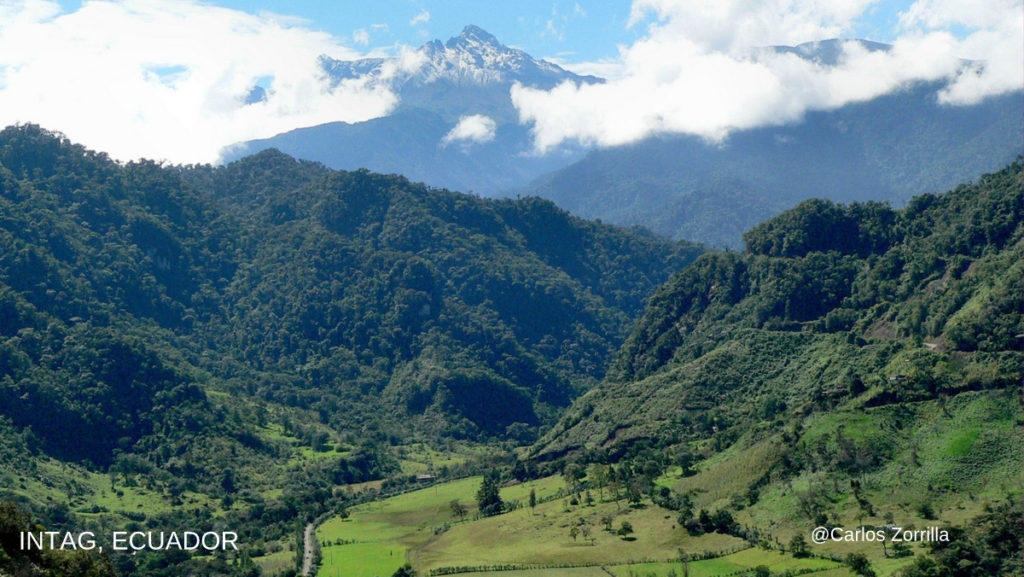
LLurimagua is the name of the mining project in northwestern Ecuador, which for decades was known as Junin. The name change was meant to disassociate it from the failure of two transnational companies to develop the project. Since 1995, first a subsidiary of the powerful Mitsubishi and then a Canadian mining company, were forced to abandon the project due to the fierce opposition of the communities and organizations in the Intag area.
Chile, the big brother, or the biggest looter?
When the mining concessions in Junín were returned to the state, around 2010, it didn’t take long for Ecuador to award them to the recently created ENAMI EP, Ecuador’s state mining company, which immediately signed an agreement with its “older brother” to train it in the oxymoron known as responsible mining. Codelco has cultivated a well-crafted reputation for being a responsible company, and Ecuador, not having a single large-scale metal mine, wanted to take advantage of Chilean know-how. It’s worth highlighting what should be obvious, that Codelco’s interest was not, and has never been, to be generous. For years, Codelco has been looking at other mining sites once it realized that its own copper deposits were becoming more expensive to exploit every year.
The cost of producing a ton of Chilean copper has become more expensive basically due to five factors: high levels of arsenic in its deposits; relatively high cost of labor; high cost of electricity, along with a notable drop in the copper content of the deposits, and growing water shortage. Most of Codelco’s mines are located in the Atacama Desert and surrounding regions, and access to water has become increasingly problematic and expensive. On the other hand, compared to the rest of South America, and especially Ecuador, there are very few communities in the Chilean desert; the most arid on the planet. In contrast, in the 4,839 hectares of the Llurimagua concession, there are six communities within or adjacent to it.
Sanctuary of biodiversity and archaeological jewel
Northwestern Ecuador, where the mining project is located, is part of the Tropical Andes, the hottest of the planet’s 36 Biodiversity Hotspots. In 2018, researchers identified 279 endangered animal species on the IUCN Red List in or near the forests now threatened by the copper mining project. The list does not include hundreds of other species on Ecuador’s red lists; many of which are critically endangered. Nor does it include the two recently found endemic frog species that exist within the mining concession and nowhere else in the world. In 2017, biologists hired to prepare the new Environmental Impact Study for the expansion of the advanced exploration phase recorded three critically endangered animal species, including a spider monkey (Ateles fusciceps). Given the impacts of mining, they recognized that there is a high risk that the critically endangered species will become extinct. Interestingly, compared to the better-known Amazon region, the mountain forests of northwestern Ecuador contain many more endangered species, and are more threatened.
All environmental impact studies carried out by the different companies interested in mining in Intag have identified pre-Inca archaeological remains in the mining area. This includes the archaeologists hired in 2017 for the last of these studies, despite not being able to access 50% of the pre-selected sites. There are vestiges of pre-Inca cultures throughout the Intag area, but especially in the mining area and surrounding areas, of which not much is known. Mining would erase this cultural heritage from the nation.
Today, the project is in the pre-feasibility phase; that is, the phase to establish whether the copper mine would be profitable. Meanwhile, Enami and Codelco have been waiting for over a year for their Environmental Impact Study to be approved, in order to extend advanced exploration to another part of the concession. The expansion will impact an area rich in archaeological sites, primary forests and pristine rivers and streams. But first they must resolve a host of other problems, beginning with the multiple irregularities and illegalities detected by the State Comptroller General’s Office in 2019, as well as reach a consensus on how to divide the “pie”, which seems to have become a major obstacle due to Ecuador’s political instability. The inconceivable geophysical and environmental challenges of the mining area, which made the American geologist Steven Emerman conclude that Llurimagua is the most dangerous mining project he has ever evaluated, adds to the dozens of other challenges and uncertainties the unfortunate mining project faces.
Human Rights and Resistance
Intag is known as a symbol of resistance to mining, not only in Ecuador, but in Latin America. For 25 years, communities have been actively defending their rights, driving out two mining companies and creating sustainable productive alternatives. It is a place with a long history of human rights violations, but also of resistance. The scenario, as much as the companies and the government want to whitewash it, is characterized by communities resisting mining development, and intent on living in peace and having their rights respected. If Codelco insists on deceiving the Chilean people that there is no firm and determined opposition in Intag, it will end up in the same dead end that the two expelled transnational companies got themselves into in the not so distant past.
1) Information based on the Environmental Impact Study financed by the Japan International Cooperation Agency, and other environmental impact studies and investigations.
2) Evaluation by expert geologist Steven Emerman (Phd)/Malach Consulting
For more information visit www.codelcoecuador.com and www.decoin.org
